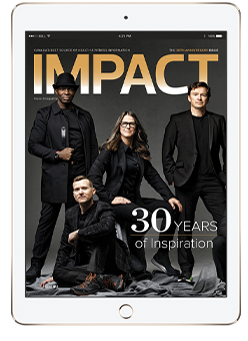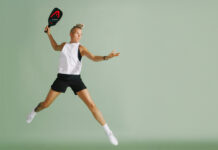
Fitness has been through many evolutions in the past three decades. We’ve gone from high impact to low impact workouts, leg warmers to wicking fabrics, high intensity interval training to the controlled movement of Pilates and yoga. Spin and barre classes have taken over from step aerobics. The use of wearable technology has grown by leaps and bounds. They all have one goal in mind. To get you fitter, healthier and happier.
As IMPACT Magazine celebrates its 30th Anniversary, they asked me to peer into my crystal ball as a relatively recent kinesiology graduate and clinical exercise specialist to ponder what the future of fitness holds. After all, this will be my career for the next 30 years.
The COVID-19 pandemic caused some seismic shifts in the way we exercise. With gyms closed, people turned to online training and coaching to stay fit. But the pandemic has also shown us that it can be difficult to separate fact from fiction, even while possessing advanced training and education. There is no shortage of so-called experts and gurus and it can be difficult to find a credible source for advice on physical health and fitness. The pandemic has also made it clear that the ability to communicate science is both an art and skill that requires training and refining.
The American College of Sports Medicine releases an annual report outlining the top health and fitness trends from around the world. The No. 1 trend for 2021 was online training, moving up from the 26th place from the previous year. There is no doubt that online exercise is here to stay, however another trend is emerging. As pandemic restrictions are being lifted and safety precautions are taking place, we are seeing a desire to return to in-person activities led by qualified and educated exercise and health professionals. Future-forward trainers, kinesiologists and exercise physiologist need superior interpersonal and communication skills complemented by knowledge of scientific principles to set the stage for such evidence-based practice.
The essence of this is a powerful factor that can separate adequate health and fitness professionals from those who are exceptional. I remember hearing the notion that to truly demonstrate that you have a comprehensive understanding of a subject, you should be able to explain it so a five-year old can understand. As we return to face-to-face fitness, seeking advice and consultation from qualified and educated fitness professionals will be among the most important trends to watch.
Online exercise is great, but people still seek the personal connection that doesn’t exist in the virtual realm.
Top 20 Worldwide Fitness Trends for 2021
- Online training
- Wearable technology
- Body weight training
- Outdoor activities
- HIIT
- Virtual training
- Exercise is medicine
- Strength training with free weights
- Fitness programs for older adults
- Personal training
- Health/wellness coaching
- Mobile exercise apps
- Employing certified fitness professionals
- Functional fitness training
- Yoga
- Exercise for weight loss
- Group training
- Lifestyle medicine
- Licensure for fitness professionals
- Outcome measurements
Photography by Ben Owens

Read This Story in Our 30th Anniversary Digital Edition
Celebrate 30 years of Canada’s best health and fitness publication!
Explore future trends in health, fitness and food in this special 30th anniversary edition. Find our favourite tech and kitchen must-haves, then work out with two of IMPACT Magazine’s Canada’s Top Fitness Trainers before making one of our delicious plant-based recipes – all inside this issue!
















